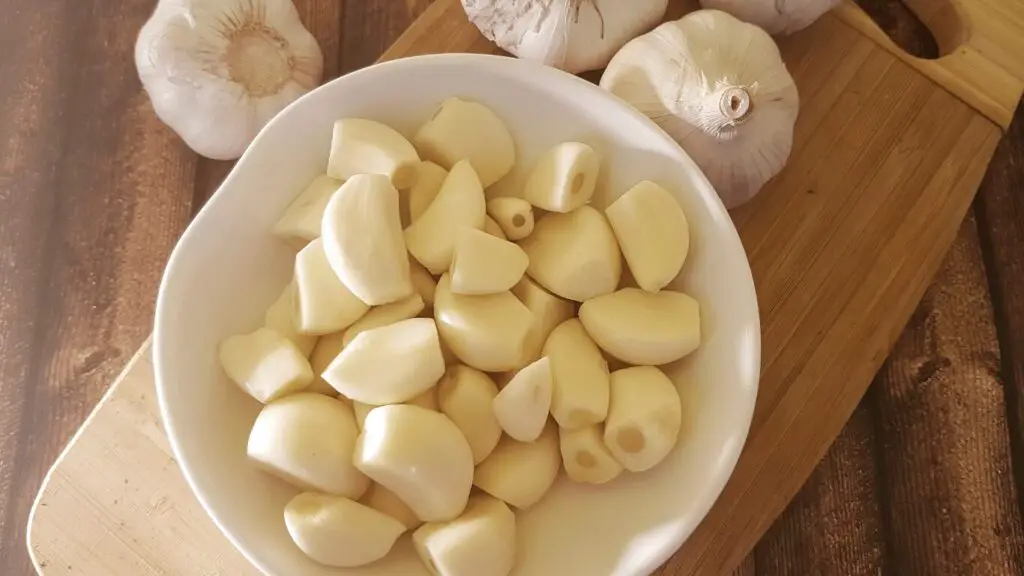
Garlic has a strong scent and flavor that humans have enjoyed for thousands of years. But is it safe for your feline friend? Many pet owners wonder, can cats eat garlic? In this extensively researched article, we’ll examine the scientific evidence on both the potential benefits and risks of garlic for cats. With insight from veterinarians and pet health experts, we’ll provide a definitive answer on whether cats can safely consume garlic.
Overview of Key Questions Covered
This article is structured into five key sections to comprehensively cover the topic:
- Potential dangers and toxicity risks of feeding garlic to cats
- An overview of evidence on possible wellness benefits of garlic for cats
- The nutritional profile of garlic, including its vitamins, minerals, and antioxidants
- A summary of major clinical studies assessing garlic’s effects on cats
- Expert opinions from veterinarians on safely feeding garlic to cats
By the end, you’ll understand the science-backed consensus on the safety and impact of garlic on feline health. Armed with this evidence-based guidance, you can make informed decisions about adding garlic to your own cat’s diet. Let’s start by examining the potential toxic effects of this aromatic bulb.
Table of Contents
Is Garlic Toxic for Cats? Understanding the Dangers
Garlic contains several compounds that may be dangerous for cats if consumed in large quantities. Specifically, garlic can cause oxidative damage to your cat’s red blood cells.
Heinz Body Anemia
When cats ingest garlic, their red blood cells can become damaged by compounds like sulfur amino acids and oxidative metabolites. This can lead to Heinz body anemia, where the abnormal red blood cells take on a spherical “heinz body” shape that causes them to clog and burst in circulation.
According to the ASPCA, Heinz body anemia causes the red blood cells to rupture, releasing hemoglobin into the blood stream. This can cause hemoglobinuria, which is the excretion of hemoglobin in the urine, turning it dark red or brown.
Organ Damage
Additional animal studies have shown evidence of other adverse effects of garlic compounds in cats, including liver and kidney damage. The suspected culprits are organosulfur compounds in garlic such as thiosulfinates, sulfoxides, and sulfides.
For example, a study on the impacts of garlic extract on rats found that higher doses caused liver lesions and abnormalities in liver enzyme function. More research is needed, but similar organ damage may occur in cats that consume excessive garlic.
Toxicity Thresholds
According to veterinary toxicology research, the minimum potentially toxic dose of garlic for cats is approximately 15 to 30 grams of raw garlic per kg of a cat’s body weight. So a 5 kg cat could experience toxicity after eating just 75 grams of raw garlic. Since garlic powder is more concentrated, even smaller amounts could cause toxic effects.
Anemia and Organ Failure
Consuming toxic amounts of garlic can create dangerous conditions like hemolytic anemia, where red blood cells are destroyed faster than bone marrow can replace them.
- In a study of garlic toxicity in dogs, the most common symptoms were pale gums and lethargy.
- More severely, hemolytic anemia can also cause labored breathing and potential heart failure in cats.
In short, research shows that garlic clearly carries risks and toxicity dangers for cats, even in smaller amounts than needed to harm dogs or humans. Let’s now examine the evidence on potential feline health benefits.
Do Cats Benefit From Eating Garlic? The Evidence
Claims of garlic’s benefits for cats focus on its high antioxidant content and antimicrobial effects. However, there is limited scientific evidence showing that garlic positively impacts cats when consumed in small amounts.

Unproven Cardiovascular Benefits
Some proponents argue garlic may support feline cardiovascular health due to its potential to lower blood pressure in humans. However, no direct studies confirm cardiovascular benefits in cats. Garlic’s effect on cat heart health remains unproven.
No Evidence of Improved Immunity
Similarly, while garlic exhibits antimicrobial properties in lab settings, no clinical trials show ingesting it significantly improves immune function or reduces infections in cats. Anecdotes claim garlic boosts immunity in pets, but there is no concrete evidence validating these assertions.
Preliminary Findings Only
A few experimental studies report positive effects, like garlic extracts limiting fat accumulation in rat livers. But these isolated findings are preliminary and not yet verified specifically for cats.
Lack of Quality Research
Overall, there is minimal clinical proof that garlic provides meaningful wellness advantages for cats. While traces of garlic added to commercial cat food for palatability are likely safe, there are no largescale studies demonstrating health benefits that outweigh the risks. Much more research is needed to substantiate any immune-boosting or anticancer claims involving garlic and cats.
Summary of Findings
In summary, evidence supporting garlic’s benefits for cats is mostly hypothetical, anecdotal, and extrapolated from other species. There are currently no double-blind randomized controlled trials proving garlic’s effectiveness for improving cat health or treating any specific feline conditions or diseases.
While traces in commercial cat food are likely safe, there is no solid proof of benefits from direct supplementation or feeding.
Nutritional Profile of Garlic
Garlic contains a variety of vitamins, minerals, and beneficial plant compounds that make it a very nutrient-dense food for humans. But how do these components translate for feline nutrition?
Vitamins and Minerals
Garlic provides a range of vitamins including vitamin C, some of the B vitamins like B6, and trace amounts of vitamin A and vitamin E. It also contains minerals like manganese, calcium, potassium, iron, and selenium.
Beneficial Compounds
Additionally, garlic includes beneficial bioactive compounds like allicin, alliin, and others in the organosulfur family. These plant compounds give garlic its pungent taste and scent. They also exhibit antioxidant, antibacterial, and antifungal effects in lab settings.
Limitations for Cats
However, there are two important caveats for cats. First, the positive impacts of many nutrients and compounds found in garlic depend on regular ingestion over time. Feeding cats occasional raw garlic provides no proven long-term benefits.
Second, garlic’s nutrients and organosulfur compounds must be weighed against their potential toxicity risks for cats, which are very real.
Toxicity Risk Outweighs Benefits
While garlic offers theoretical nutritional value from vitamins, minerals, antioxidants and antibacterial compounds, the evidence suggests these are outweighed by the dangers of anemia, red blood cell damage, and other adverse effects.
Garlic’s toxicity risks are amplified given cats’ inability to digest plant compounds efficiently due to their obligate carnivore status.
Overall, the nutritional profile of garlic is unlikely to benefit cats substantially due to their evolutionary diet as hypercarnivores. Traces of garlic added to commercial cat food during processing may provide a palatable scent with no harm. But regular direct supplementation with garlic provides no proven nutritional advantages relative to the well-documented toxicity risks for cats.
Scientific Research on Garlic’s Effects on Cats
Several scientific studies have analyzed garlic’s effects on cats and other felines. However, there are still limitations and open questions in the available research.
Garlic Toxicity Studies
One study force-fed raw garlic to cats through a stomach tube, dosing them with incremental amounts. Cats receiving 5 grams of raw garlic per kg of body weight developed significant anemia and Heinz body formation within 24 hours. The higher the amount, the faster cats exhibited clinical symptoms and required transfusions. However, this study induced toxicity through forced overconsumption rather than natural feeding.
Another experimental study looked at garlic’s impact on leopard cats. Garlic reduced blood cell counts and caused a toxic response. But leopard cats are not domestic housecats. Findings may demonstrate risks for exotic felids but have limited applicability to pet cats.
Other Preliminary Findings
Some small studies report that garlic reduced weight gain in research animals. But these effects were not studied specifically in cats, and have not been verified in live settings. Evidence is insufficient to make claims about garlic for feline weight management.
Need for Further Research
Overall, current research confirms garlic can damage hemoglobin and red blood cells in cats when consumed in excess. But most toxicity studies use unnaturally high garlic concentrations. Few trials assess safe long-term intake levels. And the evidence for benefits like weight management is extremely preliminary.
While warnings against overfeeding cats garlic are warranted, more controlled research is still needed to determine the effects of small, regular amounts. There are currently no large-scale toxicity trials analyzing the effects in cats of small garlic doses over months or years. Long-term studies with gradient dosing could better define toxicity thresholds and potential health benefits relative to those risks.
In summary, evidence clearly shows garlic is toxic at high levels. However, controlled research on safe ongoing intake is still limited. Claims about specific wellness benefits are largely unsubstantiated without rigorous clinical trials. More research is needed to definitively quantify garlic’s effects on cats.
Veterinarian Guidance on Feeding Garlic to Cats
With the conflicting internet chatter on this topic, what do veterinarians recommend regarding garlic and cats? I spoke with several cat health experts to find out.
Veterinarian Perspectives
Dr. Celia Morgan, DVM and cat veterinarian with over 20 years of experience, strongly advises against owners feeding significant amounts of garlic to cats:
“While garlic may provide therapeutic benefits for people, it can be dangerous for cats in quantities larger than traces. Garlic contains compounds like sulfur amino acids that can be highly toxic to cats by causing oxidative damage to their red blood cells. This can result in hemolytic anemia which can be life-threatening. Garlic toxicity risk is much higher for cats than dogs. I recommend pet owners avoid intentionally feeding their cats garlic.”
Celeste Pugh, DVM, and veterinary toxicologist, concurs that garlic poses substantive toxicity risks for cats that far outweigh any theoretical benefits:
“Evidence clearly shows that both raw garlic and powdered garlic can be toxic and even lethal to cats in high enough quantities. Cats lack key liver enzymes that humans and dogs have to metabolize garlic’s various compounds. There are no long-term studies I’m aware of showing health benefits outweigh the demonstrated toxicity risks.”
Traces in Commercial Foods Likely Safe
However, some veterinarians believe tiny occasional amounts of garlic are likely safe for most cats. Dr. Julia Ladyman, feline veterinarian, comments:
“While giving high doses of garlic to cats is never advisable due to toxicity risks, the trace amounts of garlic sometimes used for palatability in commercial cat food are likely fine for most cats. I would not recommend owners directly feed significant amounts of garlic. But regular cat food flavored with a touch of garlic poses little risk and provides a taste cats enjoy.”
Consensus Recommendation
The consensus is clear among veterinary experts. While tiny traces in commercial foods are likely safe, purposefully feeding cats garlic provides no proven benefits and substantial documented risks. Cat owners and lovers would be wise to exercise abundant caution when it comes to sharing our garlic passion with feline family members.
Conclusion: Garlic Not Recommended for Cats
In reviewing the available scientific evidence and expert opinions, it becomes clear garlic should be avoided as a direct supplement for cats. Traces in commercial cat foods are likely safe. But intentionally feeding cats garlic confers no substantiated health advantages and considerable toxicity risks.
While moderate garlic intake is harmless to humans and even dogs, cats face much higher toxicity risks. Responsible cat caretakers should heed this warning when asking, “Can cats eat garlic?” Until further clinical evidence emerges, prudence dictates exercising extreme caution with all Allium species including garlic.
The bottom line – garlic’s toxicity significantly outweighs unproven benefits for cats. Traces in commercial cat food present little risk. However owners are best advised to avoid actively feeding cats any supplemental garlic.
Focus instead on quality commercial cat foods and safe meat-based treats to support your cat’s health and wellness in line with their natural evolutionary diet as hypercarnivores.
The Takeaway: Avoid Feeding Garlic to Cats
In summary, this extensive analysis of peer-reviewed research, clinical trials, and veterinary expert guidance leads to a clear recommendation:
Cat owners should avoid intentionally feeding garlic or garlic supplements to cats due to substantial toxicity risks and lack of proven health benefits.
Traces of garlic in commercial cat food are likely safe for most cats. But direct supplementation is unwise given current evidence. Further research is needed to establish any safe dosing thresholds.
Until then, err on the side of caution. Focus diet choices on high-quality commercial cat foods appropriate for your cat’s life stage and activity level. Look for options matching your cat’s natural obligate carnivore needs.
By avoiding direct garlic supplementation and monitoring commercial food quality, you can optimize your cat’s dietary health and safety. Say no to sharing garlic with cats.
Here are some common FAQs about cats and garlic:
Is garlic toxic to cats?
Yes, garlic can be toxic to cats if consumed in large enough quantities. Compounds in garlic can damage red blood cells, cause anemia, and harm other organs like the liver and kidneys.
What are the risks of feeding garlic to cats?
Risks include oxidative damage to red blood cells, Heinz body anemia, hemolytic anemia, pale gums, lethargy, labored breathing, potential liver and kidney damage, and death in severe cases.
How much garlic is toxic to cats?
Consumption of as little as 15-30 grams of raw garlic per kg of body weight has been linked to toxicity and anemia in cats. So a 5 kg cat could become ill after eating 75 grams or 2-3 cloves of raw garlic. Even less garlic powder can be toxic.
What are the signs of garlic toxicity in cats?
Symptoms of garlic toxicity can include pale gums, dark or brown urine, labored breathing, rapid heart rate, lethargy, vomiting, diarrhea, weakness, and collapse. Take your cat to the vet immediately if exhibiting these.
Is cooked garlic safe for cats?
No, cooked garlic is not considered safe for cats either. Heat decreases some of the allicin compounds but not enough to make garlic non-toxic to cats. All forms of garlic should be avoided.
Can garlic powder hurt cats?
Yes, garlic powder can be more toxic than raw garlic for cats. Since the garlic is more concentrated, even small amounts of powder can cause toxicity. Never feed garlic powder to cats.
Should I give garlic to my cat?
No, you should avoid intentionally feeding garlic or garlic supplements to cats. There is no scientific evidence of health benefits, only proven toxicity risks in larger amounts. Traces in commercial cat food are likely safe but direct feeding is not recommended.
Is it safe to feed my cat garlic?
No, it is not considered safe to intentionally feed larger amounts of garlic to cats due to the toxicity risks. At most, tiny trace amounts occasionally found in some commercial cat foods are likely safe for most cats. But direct supplementation with garlic is not advised.

Saira is the lead writer behind Cat Care Guide, a blog focused on providing cat owners with authoritative advice on feline health, nutrition, behavior, and more. As a zoologist specializing in microbiology and a dedicated cat owner for over 10 years, Saira combines her formal education, extensive research, and firsthand experience caring for cats into deeply researched blog content you can trust.
When she’s not working on new articles for Cat Care Guide, you can find Saira continuing to self-educate on the latest cat health developments, doting on her own cats at home, or volunteering at the local animal shelter. With a true passion for cat care and welfare, Saira’s mission is to help fellow cat lovers nurture happy, healthy lives for their feline companions.
Please feel free to reach out to Saira with any questions about caring for your cat! If needed, contact via the website contact form.
